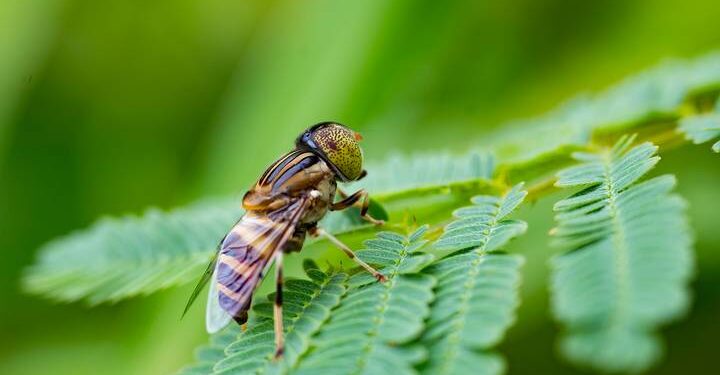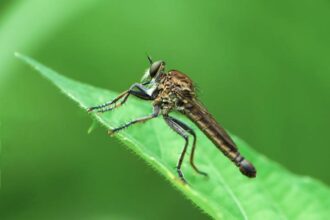What Flies Are Attracted To Naturally

Flies are tiny insects with wings, known for their buzzing nature. They appear in various shapes and hues, some quite bothersome.
These tiny creatures can be annoying as they land on our food, potentially carrying germs. If they come into contact with our meals, we may fall ill. Flies also swarm around our faces, causing further irritation.
Food and decaying matter, such as trash or animal waste, attract flies. Their preference for sweet and odorous substances leads them to linger around garbage bins and compost heaps. Therefore, maintaining cleanliness in these areas is crucial to minimize persistent flies.
Let’s discover what flies are attracted to naturally.
Garbage
Garbage consists of waste materials like discarded food scraps, packaging, and other undesired items. Flies find garbage enticing for the organic matter it contains, such as leftovers and decaying substances. These elements offer a food source for flies, and they are particularly drawn to the smell of rotting items in the garbage. The scent acts as a beacon, guiding the flies towards a feeding ground and a spot to lay their eggs.
By breaking down organic matter in garbage, flies consume and carry microorganisms like bacteria. While this process recycles natural materials, it contaminates food and the surroundings. This makes proper garbage management essential to preventing fly infestations.
Rotting food
Rotting food describes spoiled or decayed food, often giving off unpleasant odours and undergoing decomposition. Flies are attracted to the smell of the decomposing organic matter in rotting food. The foul aroma signals to the flies that a potential meal awaits them, drawing them closer to nourishment and reproduction.
Equipped with unique mouthparts, flies can consume liquids produced during decomposition, such as dissolved sugars and proteins. Microbes involved in breaking down food create an inviting environment for flies to lay their eggs. Using rotting food sources is a survival technique for flies, ensuring they have sustenance and a breeding location.
Animal waste
Animal waste consists of excrement or fecal matter. Flies find this waste appealing as it offers essential nutrients, moisture, and organic materials for feeding and breeding. Animal waste smells guide flies to it, where they can lay eggs and provide their offspring with needed sustenance.
Flies break down animal waste by decomposing organic matter and recycling nutrients in ecosystems. Although this has ecological benefits, it can pose problems when animal waste is close to human spaces, leading to fly infestations and possible disease transmission.
Sweet liquids
Flies are attracted to sweet liquids because of their high sugar content, which gives them a rapid energy boost. The enticing flavour entices flies to search for and consume sources like fruit juices, nectar, honey, and other sugary mixtures. Sweet liquids cater to flies’ carbohydrate needs, supporting their high metabolism and activity levels.
Flies possess specialized mouthparts designed for drinking liquid substances, making them efficient at consuming sweet liquids. These sugars offer valuable energy that flies need for daily tasks such as locating food, mating, and reproduction. Being drawn to sweet liquids is a survival tactic for flies, ensuring they obtain the energy needed to sustain their lifecycles and preserve their populations.
Overripe fruits
Fruits that have ripened too much often turn mushy, change colour, and give off a powerful, sweet smell. This aroma and the sugar released as the fruit breaks down draw flies to them. Overripe fruits are like a feast for flies, who find nutrients and a place to lay their eggs. Unfortunately, these fruits also attract other pests, including ants and rodents.
Removing or composting overripe fruits is crucial to keep flies from infesting and ensure food safety. This stops them from becoming breeding grounds for flies while also reducing the risk of spreading bacteria and causing foodborne illnesses.
Decomposing organic matter
Decomposing organic matter involves naturally breaking apart and decaying things like fallen leaves, dead plants, and animal remains. Flies find this environment appealing as it offers nutrients and an ideal spot to breed. Through decomposition, odours and chemical signals alert flies that this location is suitable for feeding and laying eggs.
As they contribute to decomposing organic material and recycling nutrients into the ecosystem, flies play an essential role in nature’s cycle. Decomposition is vital but can cause issues close to homes or other populated places. In such cases, flies may become a nuisance as they swarm around the decomposing material.
To manage this problem and limit fly attraction, proper disposal methods – such as composting or removal – are recommended. This helps minimize the potential impact of fly-related concerns from decaying organic matter within human environments.
Damp and dirty environments
Humid and grubby places are wet and full of dirt, filth, or decaying materials. Flies love these environments because they need moisture and organic matter for nourishment.
The humidity in such spots offers flies the right conditions to grow and multiply, while the presence of dirt and decomposing substances gives them excellent breeding grounds. Flies find food and water in one location, making it an ideal home. Despite its evident drawbacks, flies are good for researching ecosystems due to their ability to survive in damp, dirty environments.
Excrement
Waste matter, mainly feces, comes from animals, including humans. Flies find this waste appealing as it is packed with nutrients for them. Waste matter contains organic materials that flies can feed on and is often an ideal place to deposit their eggs. Flies contribute to waste matter decomposition by breaking it down, which recycles nutrients.
However, having flies around waste matter carries health risks since they transport harmful microorganisms. That’s why it’s not wise to attract flies to waste matter because it can contaminate our living spaces and potentially affect our health.
Fermented substances
Fermented items involve foods or drinks that have experienced fermentation, a chemical change sparked by microorganisms like yeast and bacteria. This process often creates alcohol or organic acids and alters taste, texture, and aroma.
Fermented items attract flies due to their potent and unique smells. These smells work as a cue for flies, indicating a potential food source, as some fermented items might have sugar or other elements that appeal to flies. Fermentation scent can lure flies from afar, making such things enticing.
Spoiled or decaying materials
Rotten or decomposing material has deteriorated because of bacterial and fungal activity. Flies find these materials attractive as they offer food sources. The disintegration of organic matter releases various compounds like amino acids and fatty acids, which act as nutrients for flies.
Besides providing nourishment, rotten or decomposing matter can also be ideal breeding grounds for flies. They may deposit their eggs on these materials, allowing emerging larvae, or maggots, to feed on the decaying substance while growing.


